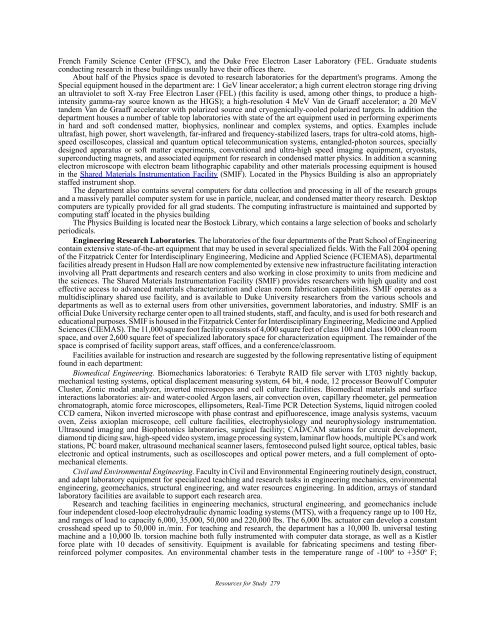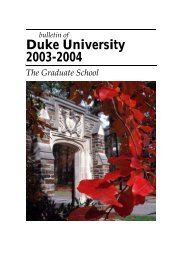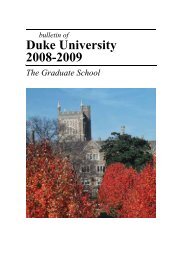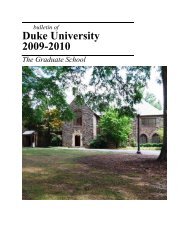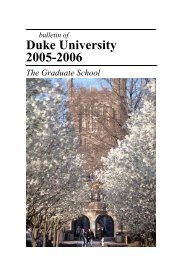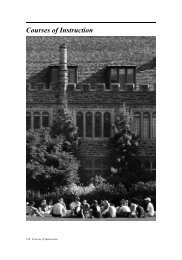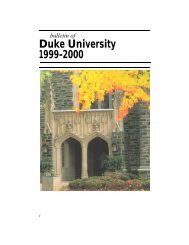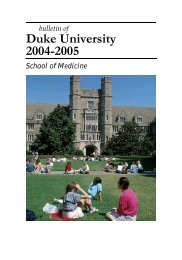Academic Calendar 2012-2013 - Office of the Registrar - Duke ...
Academic Calendar 2012-2013 - Office of the Registrar - Duke ...
Academic Calendar 2012-2013 - Office of the Registrar - Duke ...
Create successful ePaper yourself
Turn your PDF publications into a flip-book with our unique Google optimized e-Paper software.
French Family Science Center (FFSC), and <strong>the</strong> <strong>Duke</strong> Free Electron Laser Laboratory (FEL. Graduate students<br />
conducting research in <strong>the</strong>se buildings usually have <strong>the</strong>ir <strong>of</strong>fices <strong>the</strong>re.<br />
About half <strong>of</strong> <strong>the</strong> Physics space is devoted to research laboratories for <strong>the</strong> department's programs. Among <strong>the</strong><br />
Special equipment housed in <strong>the</strong> department are: 1 GeV linear accelerator; a high current electron storage ring driving<br />
an ultraviolet to s<strong>of</strong>t X-ray Free Electron Laser (FEL) (this facility is used, among o<strong>the</strong>r things, to produce a highintensity<br />
gamma-ray source known as <strong>the</strong> HIGS); a high-resolution 4 MeV Van de Graaff accelerator; a 20 MeV<br />
tandem Van de Graaff accelerator with polarized source and cryogenically-cooled polarized targets. In addition <strong>the</strong><br />
department houses a number <strong>of</strong> table top laboratories with state <strong>of</strong> <strong>the</strong> art equipment used in performing experiments<br />
in hard and s<strong>of</strong>t condensed matter, biophysics, nonlinear and complex systems, and optics. Examples include<br />
ultrafast, high power, short wavelength, far-infrared and frequency-stabilized lasers, traps for ultra-cold atoms, highspeed<br />
oscilloscopes, classical and quantum optical telecommunication systems, entangled-photon sources, specially<br />
designed apparatus or s<strong>of</strong>t matter experiments, conventional and ultra-high speed imaging equipment, cryostats,<br />
superconducting magnets, and associated equipment for research in condensed matter physics. In addition a scanning<br />
electron microscope with electron beam lithographic capability and o<strong>the</strong>r materials processing equipment is housed<br />
in <strong>the</strong> Shared Materials Instrumentation Facility (SMIF). Located in <strong>the</strong> Physics Building is also an appropriately<br />
staffed instrument shop.<br />
The department also contains several computers for data collection and processing in all <strong>of</strong> <strong>the</strong> research groups<br />
and a massively parallel computer system for use in particle, nuclear, and condensed matter <strong>the</strong>ory research. Desktop<br />
computers are typically provided for all grad students. The computing infrastructure is maintained and supported by<br />
computing staff located in <strong>the</strong> physics building<br />
The Physics Building is located near <strong>the</strong> Bostock Library, which contains a large selection <strong>of</strong> books and scholarly<br />
periodicals.<br />
Engineering Research Laboratories. The laboratories <strong>of</strong> <strong>the</strong> four departments <strong>of</strong> <strong>the</strong> Pratt School <strong>of</strong> Engineering<br />
contain extensive state-<strong>of</strong>-<strong>the</strong>-art equipment that may be used in several specialized fields. With <strong>the</strong> Fall 2004 opening<br />
<strong>of</strong> <strong>the</strong> Fitzpatrick Center for Interdisciplinary Engineering, Medicine and Applied Science (FCIEMAS), departmental<br />
facilities already present in Hudson Hall are now complemented by extensive new infrastructure facilitating interaction<br />
involving all Pratt departments and research centers and also working in close proximity to units from medicine and<br />
<strong>the</strong> sciences. The Shared Materials Instrumentation Facility (SMIF) provides researchers with high quality and cost<br />
effective access to advanced materials characterization and clean room fabrication capabilities. SMIF operates as a<br />
multidisciplinary shared use facility, and is available to <strong>Duke</strong> University researchers from <strong>the</strong> various schools and<br />
departments as well as to external users from o<strong>the</strong>r universities, government laboratories, and industry. SMIF is an<br />
<strong>of</strong>ficial <strong>Duke</strong> University recharge center open to all trained students, staff, and faculty, and is used for both research and<br />
educational purposes. SMIF is housed in <strong>the</strong> Fitzpatrick Center for Interdisciplinary Engineering, Medicine and Applied<br />
Sciences (CIEMAS). The 11,000 square foot facility consists <strong>of</strong> 4,000 square feet <strong>of</strong> class 100 and class 1000 clean room<br />
space, and over 2,600 square feet <strong>of</strong> specialized laboratory space for characterization equipment. The remainder <strong>of</strong> <strong>the</strong><br />
space is comprised <strong>of</strong> facility support areas, staff <strong>of</strong>fices, and a conference/classroom.<br />
Facilities available for instruction and research are suggested by <strong>the</strong> following representative listing <strong>of</strong> equipment<br />
found in each department:<br />
Biomedical Engineering. Biomechanics laboratories: 6 Terabyte RAID file server with LT03 nightly backup,<br />
mechanical testing systems, optical displacement measuring system, 64 bit, 4 node, 12 processor Beowulf Computer<br />
Cluster, Zonic modal analyzer, inverted microscopes and cell culture facilities. Biomedical materials and surface<br />
interactions laboratories: air- and water-cooled Argon lasers, air convection oven, capillary rheometer, gel permeation<br />
chromatograph, atomic force microscopes, ellipsometers, Real-Time PCR Detection Systems, liquid nitrogen cooled<br />
CCD camera, Nikon inverted microscope with phase contrast and epifluorescence, image analysis systems, vacuum<br />
oven, Zeiss axioplan microscope, cell culture facilities, electrophysiology and neurophysiology instrumentation.<br />
Ultrasound imaging and Biophotonics laboratories, surgical facility; CAD/CAM stations for circuit development,<br />
diamond tip dicing saw, high-speed video system, image processing system, laminar flow hoods, multiple PCs and work<br />
stations, PC board maker, ultrasound mechanical scanner lasers, femtosecond pulsed light source, optical tables, basic<br />
electronic and optical instruments, such as oscilloscopes and optical power meters, and a full complement <strong>of</strong> optomechanical<br />
elements.<br />
Civil and Environmental Engineering. Faculty in Civil and Environmental Engineering routinely design, construct,<br />
and adapt laboratory equipment for specialized teaching and research tasks in engineering mechanics, environmental<br />
engineering, geomechanics, structural engineering, and water resources engineering. In addition, arrays <strong>of</strong> standard<br />
laboratory facilities are available to support each research area.<br />
Research and teaching facilities in engineering mechanics, structural engineering, and geomechanics include<br />
four independent closed-loop electrohydraulic dynamic loading systems (MTS), with a frequency range up to 100 Hz,<br />
and ranges <strong>of</strong> load to capacity 6,000, 35,000, 50,000 and 220,000 lbs. The 6,000 lbs. actuator can develop a constant<br />
crosshead speed up to 50,000 in./min. For teaching and research, <strong>the</strong> department has a 10,000 lb. universal testing<br />
machine and a 10,000 lb. torsion machine both fully instrumented with computer data storage, as well as a Kistler<br />
force plate with 10 decades <strong>of</strong> sensitivity. Equipment is available for fabricating specimens and testing fiberreinforced<br />
polymer composites. An environmental chamber tests in <strong>the</strong> temperature range <strong>of</strong> -100º to +350º F;<br />
Resources for Study 279


